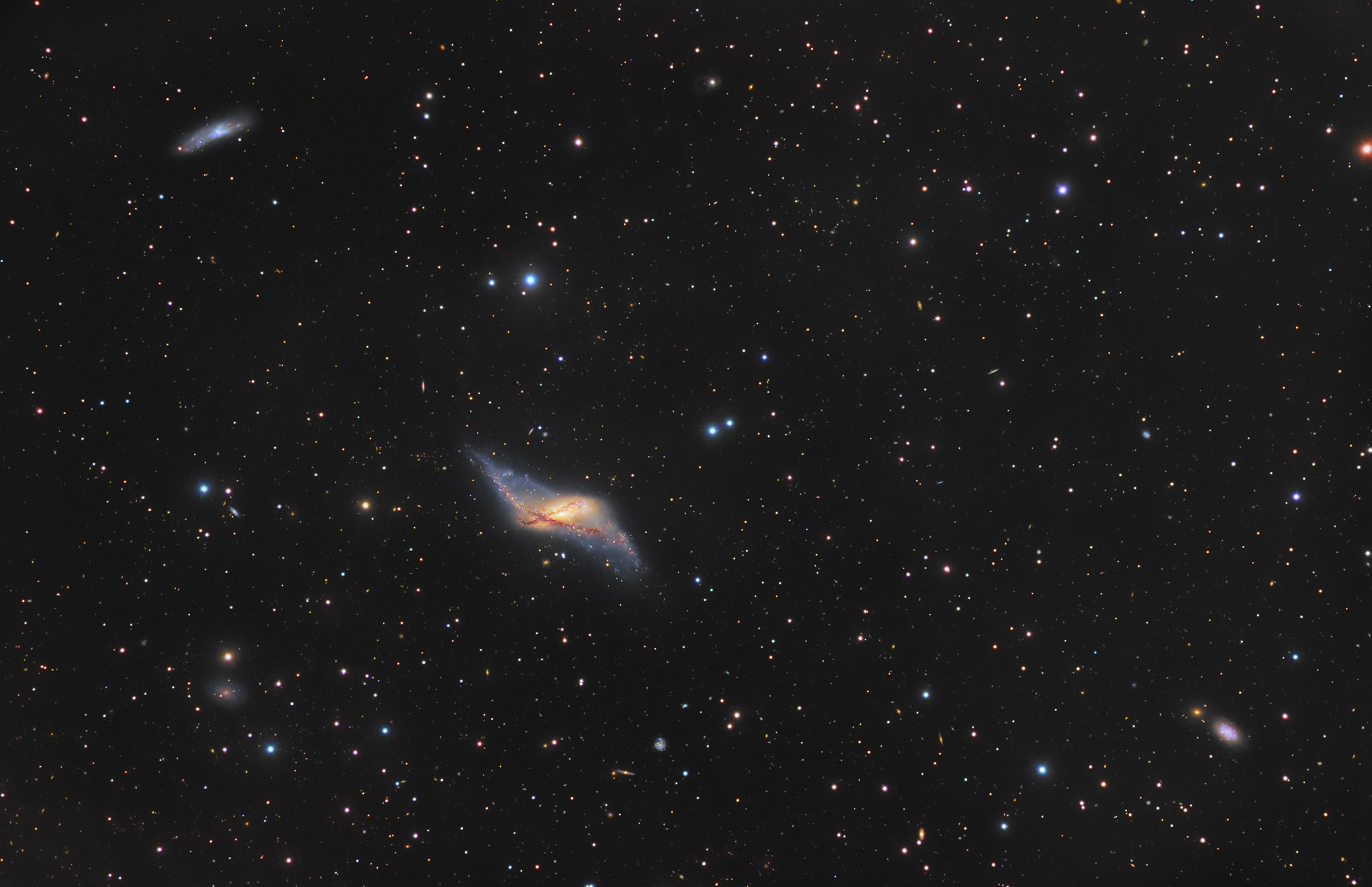[/caption]
No. This polar ring isn’t a phone call from Santa, but an unusual interacting galaxy designated as NGC 660. Located over 20 million light-years away, this member of the M74 group located in the constellation of Pisces is rare breed – a “polar ring” galaxy – a bizarre configuration of stars, gas, and dust orbiting in ring formations nearly perpendicular to the plane of a flat galactic disk. What caused it? Read on…
Polar ring galaxies are believed to have formed from a spectacular collision of two galaxies who shared a common past. While they may not have merged, the encounter could have left a debris trail which encircles the host galaxy’s disk. “High-resolution interferometric data of the H I and OH absorption in the nuclear region of NGC 660 reveal three distinct absorbing structures. The central disk of the galaxy with a large velocity gradient dominates the absorption signature. The gas in the warped outer disk appears in absorption close to the systemic velocity; the outer rings of the warp located at large radii are moving in front of the nuclear radio source.” says Willema Baan (et al), “Third, an outflowing feature can be seen at the center of the radio source at 100 km/s below the systemic velocity. This mostly molecular feature could be due to a perturbed spiral structure in the inner regions of the disk.”
But, when it comes to NGC 660, the explanation might not quite be as straight forward. Apparently from our line of sight, the area of the ring closest to us doesn’t cross that galactic plane in the middle- but off to one side. This gives us a unique opportunity to study the shape of this galaxy’s hidden dark matter halo by calculating the enigma’s gravitational influence on the rotation of the ring and disk – a mass of starburst activity! Within the ring itself are an estimated 500 clusters where stars are continuously being born with the youngest of the siblings estimated to be about 7 million years old.
“NGC 660 contains concentrated central star formation of power ~ 2 x 1010~ Lsun. Our 1.3 cm continuum image reveals a bright, compact source of less than 10 pc extent with a rising spectral index. We infer that this is optically thick free-free emission from a super star cluster nebula. The nebula is less than 10 pc in size, comparable in luminosity to the “supernebula” in the dwarf galaxy, NGC 5253.” says J.P. Naiman, “We estimate that there are a few thousand O stars contained in this single young cluster. There are a number of other weaker continuum sources, either slightly smaller or more evolved clusters of similar size within the central 300 parsecs of the galaxy.”
But that’s not all that’s hiding in NGC 660, its unusual profile gives us an opportunity to study what happens to molecular gas densities when galaxies collide, too. It opens the mysterious phenomena of megamasers and kilomasers. “Contrary to conventional wisdom, IR luminosity does not dictate OHM formation; both star formation and OHM activity are consequences of tidal density enhancements accompanying galaxy interactions. The OHM fraction in starbursts is likely due to the fraction of mergers experiencing a temporal
spike in tidally driven density enhancement.” says Jeremy Darling. “OHMs are thus signposts marking the most intense, compact, and unusual modes of star formation in the local universe. Future high-redshift OHM surveys can now be interpreted in a star formation and galaxy evolution context, indicating both the merging rate of galaxies and the burst contribution to star formation.”
But what about things we can’t see? Things far more powerful in the electromagnetic spectrum than those given off by Cassiopeia A… Compact radio sources! “Nuclei of starburst galaxies are often obscured by dust and hence are probed best in non-visual wavelength regimes such as the infrared and radio.” sys A. Wiercigroch (JPL). “A number of the compact sources appear to lie along a ring projected against the more diffuse radio emission in the galaxy’s nuclear region.”
Not bad for just another Christmas story….
Credits: Image processing Dietmar Hager and Immo Gerber. Image Acquistion at Tao Observatory. We thank you so much!


What a fascinating object. This galaxy is strange even for a polar ring galaxy. The host galaxy is a spiral, not the usual elliptical or lenticular galaxy seen in other PRGs. And, obviously, the surrounding ring is not truly “polar” but is inclined to the disk of the host galaxy by ~55 degrees. As noted, this unusual geometry can be exploited to infer the distribution of dark matter in this system.
Tammy, could you provide the sources you consulted for this article? I’m not familiar with papers you cited and would like to check them out. 🙂
I’m also left wondering why this object didn’t make it into the Arp Atlas of Peculiar Galaxies.
absolutely no problem:
Willema Baan – http://adsabs.harvard.edu/full/1992ApJ…401..508B
JP Naiman – http://aas.org/archives/BAAS/v36n5/aas205/1591.htm
Jeremy Darling – http://arxiv.org/pdf/0710.1080
A. Wiercigroch – http://trs-new.jpl.nasa.gov/dspace/bitstream/2014/31789/1/95-1335.pdf
enjoy! i did… and it sure made for some fascinating reading. there are several more on the subject of NGC 660, too… but the article would have ended up being 2000 words long!
😉
Fantastic, these will make for some good weekend reading! Thanks, Tammy 🙂
Something interacted with this galaxy to change the angular momentum. That is a lot of angular momentum transfer. I suspect the inner disk and outer ring must have opposite Delta-J, J = angular momentum.
LC